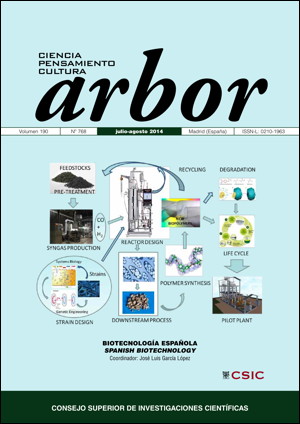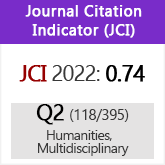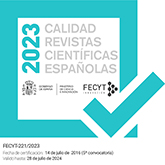La biotecnología en sanidad animal
DOI:
https://doi.org/10.3989/arbor.2014.768n4008Palabras clave:
Vacunación, VLPs, diagnóstico, inmunoensayos, DIVA, ensayos múltiples, ensayos de campo, PCRResumen
El crecimiento de la población mundial en los próximos años, provocará un incremento en la demanda de alimentos. Como consecuencia, el número de animales de producción sufrirá un aumento importante y la Sanidad Animal constituirá un elemento crítico a la hora de tratar y prevenir las enfermedades, garantizando el abastecimiento y la seguridad. La biotecnología contribuye de múltiples formas al desarrollo de la Sanidad Animal. Fundamentalmente, aporta herramientas que ayudan al control y erradicación de las enfermedades. El desarrollo de la ingeniería genética en las últimas décadas ha favorecido el avance de la industria biotecnológica aplicada a la sanidad humana y animal. Existen un gran número de ensayos de diagnóstico basados en desarrollos biotecnológicos, así mismo, cada vez hay más vacunas recombinantes contra enfermedades animales. La prevención y control eficientes de las enfermedades dependerán de mecanismos de detección temprana, que faciliten la toma de decisiones y una respuesta rápida.
Descargas
Citas
Antonis, A.F., Bruschke, C. J., Rueda, P., Maranga, L., Casas, J. I., Vela, C., Hilgers, L. A., Belt, P. B., Weerdmeester, K., Carrondo, M. J. y Langeveld, J. P.(2006). A novel recombinant virus-like particles vaccine for prevention of porcine parvovirus-induced reproductive failure. Vaccine, 24, pp. 5481-5490. http://dx.doi.org/10.1016/j.vaccine.2006.03.089 PMid:16730104
Barzon, L., Lavezzo, E., Costanzi, G., Franchin, E., Toppo, S. y Palù, G. (2013). Next-generation sequencing technologies in diagnostic virology. Journal of Clinical Virology, 58, pp. 346-350. http://dx.doi.org/10.1016/j.jcv.2013.03.003 PMid:23523339
Brun, A., Bárcena, J., Blanco, E., Borrego, B., Dory, D., Escribano, J. M., Le Gall-Reculé, G., Ortego, J y Dixon, L. K.(2011).Current strategies for subunit and genetic viral veterinary vaccine development. Virus Research, 157, pp. 1-12. http://dx.doi.org/10.1016/j.virusres.2011.02.006 PMid:21316403
Chiu, C. Y. (2013). Viral pathogen discovery. Current Opinion in Microbiology, 16, pp. 468-478. http://dx.doi.org/10.1016/j.mib.2013.05.001 PMid:23725672
Crisci, E., Bárcena, J. y Montoya, M. (2012). Virus-like particles: the new frontier of vaccines for animal viral infections. Veterinary Immunology and Immunopathology, 148, pp. 211-225. http://dx.doi.org/10.1016/j.vetimm.2012.04.026 PMid:22705417
Ellington, A. y Szostak, J. (1990). In vitro selection of RNA molecules that bind specific ligands. Nature, 346, pp. 818-822. http://dx.doi.org/10.1038/346818a0 PMid:1697402
Goller, K. V., Hoper, D., Schirmeier, H., Mettenleiter, T. C. y Beer, M. (2012). Schmallenberg virus as possible ancestor of Shamonda virus. Emerging Infectious Diseases, 10, pp. 1644-1646.
Jackwood, M.W., Hickle, L., Kapil, S. y Silva, R. (2008). Vaccine development using recombinant DNA technology. Animal Agriculture's Future through Biotechnology, part 7. Council for Agricultural Science and Technology (CAST), nº 38. (2009) . Biotechnology in the diagnosis of infectious diseases and vaccine development. En OIE Terrestrial Manual .
James, H. E., Ebert, K., McGonigle, R., Reid, S. M., Boonham, N., Tomlinson, J. A., Hutchings, G. H., Denyer, M., Oura, C. A., Dukes, J. P. y King, D. P. (2010). Detection of African swine fever virus by loop-mediated isothermal amplification. Journal of Virological Methods, 164, pp. 68-74. http://dx.doi.org/10.1016/j.jviromet.2009.11.034 PMid:19963011
Hess, M., Neubauer, C. y Hackl, R. (2007). Interlaboratory comparison of ability to detect nucleic acid of Mycoplasma gallisepticum and Mycoplasma synoviae by polymerase chain reaction. Avian Pathology. Journal of the WVPA, 36, pp. 127-133. http://dx.doi.org/10.1080/03079450701203082 PMid:17479373
Köhler, G. y Milstein, C. (1975). Continuous cultures of fused cells secreting antibody of determined specificity. Nature, 256, pp. 495-497. http://dx.doi.org/10.1038/256495a0 PMid:1172191
Lanyon, S. R., Hill, F. I., Reichel, M. P. y Brownlie, J. (2014). Bovine viral diarrhoea: pathogenesis and diagnosis. The Veterinary Journal, 199, pp. 201-209. http://dx.doi.org/10.1016/j.tvjl.2013.07.024 PMid:24053990
Libeau, G., Diallo, A., Colas, F. y Guerre, L. (1994). Rapid differential diagnosis of rinderpest and pestes des petits ruminants using an immunocapture ELISA. Veterinary Record, 134, pp. 300-304. http://dx.doi.org/10.1136/vr.134.12.300 PMid:8009788
Liu, C. H., Chaung, H. C., Chang, H. L., Peng, Y. T. y Chung, W. B. (2009). Expression of Toll-like receptor mRNA and cytokines in pigs infected with porcine reproductive and respiratory syndrome virus. Veterinary Microbiology, 136, pp. 266-276. http://dx.doi.org/10.1016/j.vetmic.2008.11.016 PMid:19124206
Liu, F., Ge, S., Li, L., Wu, X., Liu, Z. y Wang, Z. (2012). Virus-like particles: potential veterinary vaccine immunogens. Research in Veterinary Science, 93, pp. 553-559. http://dx.doi.org/10.1016/j.rvsc.2011.10.018 PMid:22100244
López-Go-i, I., García-Yoldi, D., Marín, C. M., Miguel, M. J. de, Barquero-Calvo, E., Guzmán-Verri, C., Albert, D. y Garin-Bastuji, B. (2011). New Bruce-ladder multiplex PCR assay for the biovar typing of Brucellasuis and the discrimination of Brucellasuis and Brucellacanis. Veterinary Microbiology, 154, pp. 152-155. http://dx.doi.org/10.1016/j.vetmic.2011.06.035 PMid:21782356
López-Go-i, I., García-Yoldi, D., Marín, C. M., Miguel, M. J. de, Mu-oz, P. M., Blasco, J. M., Jacques, I., Grayon, M., Cloekaert, A., Ferreira, A. C., Cardoso, R., Correa de Sá, M. I., Walravens, K., Albert, D. y Garin-Bastuji, B. (2008). Evaluation of a multiplex PCR assay (Bruce-ladder) for molecular typing of all Brucella species, including the vaccine strains. Journal of Clinical Microbiology, 46, pp. 3484-3487. http://dx.doi.org/10.1128/JCM.00837-08 PMid:18716225 PMCid:PMC2566117
Ma, W., Lager, K. M., Richt, J. A., Stoffregen, W. C., Zhou, F. y Yoon, K. J. (2008). Development of real-time polymerase chain reaction assays for rapid detection and differentiation of wild-type pseudora bies and gene deleted vaccine viruses. Journal of Veterinary Diagnostic Investigation, 20, pp. 440-447. http://dx.doi.org/10.1177/104063870802000405 PMid:18599848
Mahajan, V., Banga, H. S., Deka, D., Filia, G. y Gupta, A. (2013). Comparison of diagnostic tests for diagnosis of infectious bovine rhinotracheitis in natural cases of bovine abortion. Journal of Comparative Pathology, 149, pp. 391-401. http://dx.doi.org/10.1016/j.jcpa.2013.05.002 PMid:23885803
Marangon, S., Bortolotti, L., Capua, I., Bettio, M. y dalla Pozza, M. (2003). Low-pathogenicity avian influenza (LPAI) in Italy (2000-01): epidemiology and control. Avian Diseases, 47 (3 Suppl), pp. 1006-1009. http://dx.doi.org/10.1637/0005-2086-47.s3.1006
Marangon, S., Cecchinato, M. y Capua, I. (2008). Use of vaccination in avian influenza control and eradication. Zoonoses and Public Health, 55, pp. 65-72. http://dx.doi.org/10.1111/j.1863-2378.2007.01086.x PMid:18201329
Meeusen, E. N.T., Walker, J., Peters, A., Pastoret, P. P. y Jungersen, G. (2007). Current status of veterinary vaccines. Clinical Microbiology Reviews, 20, pp. 489-510. http://dx.doi.org/10.1128/CMR.00005-07 PMid:17630337 PMCid:PMC1932753
Mignon, B., Dubuisson, J., Baranowski, E., Koromyslov, I., Ernst, E., Boulanger, D., Waxweiler, S. y Pastoret, P.-P. (1991). A monoclonal ELISA for bovine viral diarrhea pestivirus antigen detection in persistently infected cattle. Journal of Virological Methods, 35, pp. 177-188. http://dx.doi.org/10.1016/0166-0934(91)90133-K
Rodríguez Ferri, E.F. (2012). Sanidad animal y nuevas tecnologías. Profesión Veterinaria, 77, pp. 61-98.
Roy P. y Noad, R. (2008). Virus-like particles as a vaccine delivery system: myths and facts. Human Vaccines, 4, pp. 5-12. http://dx.doi.org/10.4161/hv.4.1.5559
Rueda, P., Martínez-Torrecuadrada, J. L., Sarraseca, J., Sedlik, C., Barrio, M. del, Hurtado, A., Leclerc, C. y Casal, J. I. (1999). Engineering parvovirus-like particles for the induction of B-cell, CD4+ and CTL responses. Vaccine, 18, pp. 325-332. http://dx.doi.org/10.1016/S0264-410X(99)00202-9
Schynts, F., Baranowski, E., Lemaire, M. y Thiry, E. (1999). A specific PCR to differentiate between gE negative vaccine and wildtype bovine herpesvirus type 1 strains. Veterinary Microbiology, 66, pp. 187-195. http://dx.doi.org/10.1016/S0378-1135(99)00008-5
Smith, G. P. y Petrenko V. A. (1997). Phage Display. Chemical Review, 97, pp. 391-410. http://dx.doi.org/10.1021/cr960065d
Stoltenburg, R., Reinemann, C., Strehlitz, B. (2007). SELEX-a(r)evolutionary method to generate high-affinity nucleic acid ligands. Biomolecular Engineering, 24, pp. 381-403. http://dx.doi.org/10.1016/j.bioeng.2007.06.001 PMid:17627883
Trueblood, E. S, McGuire, T. C. y Palmer, G. H. (1991). Detection of Anaplasma marginale rickettsemia prior to onset of clinical signs by using an antigen capture enzyme-linked immunosorbent assay. Journal of Clinical Microbiology, 29, p. 1542. PMid:1885753 PMCid:PMC270153
Tuerk, C. y Gold, L. (1990). Systematic evolution of ligands by exponential enrichment: RNA ligands to bacteriophage T4 DNA polymerase. Science, 249, pp. 505-510. http://dx.doi.org/10.1126/science.2200121 PMid:2200121
Zeltins, A. (2013). Construction and characterization of Virus-like Particles: a review. Molecular Biotecnology, 53, p. 92. http://dx.doi.org/10.1007/s12033-012-9598-4 PMid:23001867
Publicado
Cómo citar
Número
Sección
Licencia
Derechos de autor 2014 Consejo Superior de Investigaciones Científicas (CSIC)

Esta obra está bajo una licencia internacional Creative Commons Atribución 4.0.
© CSIC. Los originales publicados en las ediciones impresa y electrónica de esta Revista son propiedad del Consejo Superior de Investigaciones Científicas, siendo necesario citar la procedencia en cualquier reproducción parcial o total.Salvo indicación contraria, todos los contenidos de la edición electrónica se distribuyen bajo una licencia de uso y distribución “Creative Commons Reconocimiento 4.0 Internacional ” (CC BY 4.0). Puede consultar desde aquí la versión informativa y el texto legal de la licencia. Esta circunstancia ha de hacerse constar expresamente de esta forma cuando sea necesario.
No se autoriza el depósito en repositorios, páginas web personales o similares de cualquier otra versión distinta a la publicada por el editor.















